Data and Analytics
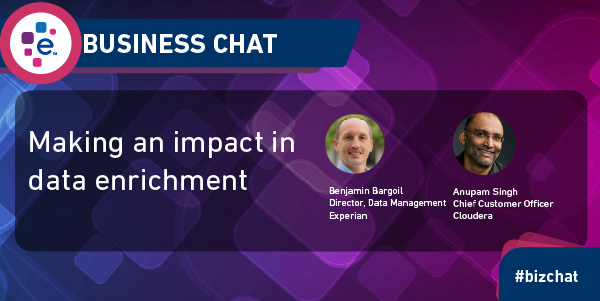
In this Business Chat, we sat down with Experian's Director of Data Management, Ben Bargoil, and Cloudera Chief Customer Officer, Anupam Singh to talk about the data management investments Experian is making in machine learning and A.I, and how these investments are helping our clients. Ben, can you share a little bit about some of the data challenges we are having here at Experian? [Ben]: Most of the challenges we've been facing and working closely with Cloudera and solving over the last say two years have been in response to growing demands from the marketplace, right? What was considered acceptable even two years ago, in terms of data coverage and data accuracy, is no longer meeting our customers' needs in the marketplace. And add to that the legacy processes and legacy environment that we operated in, we're challenged with keeping up with the variety, the volume, and the velocity of data that Experian has, and that coupled with our previous approaches to data management, that weren't flexible enough necessarily to empower these new approaches. Right? Again, most of what we wanted to solve were related to how we can continue to do what we're doing but do it in a much more efficient, much more impactful way for our customers. Anupama turning to you; what solution did Cloudera prescribe to Experian to help us address some of these challenges? [Anupam]: Machine Learning is only as good as the data, and so the solution that we provided is a comprehensive solution called Cloudera Data Science Workbench. Yes, the more charismatic part of the product is that you can do Machine Learning apps and build neural networks. But in reality, where we saw Experian needed the product is things like data de-duplication, classification. So it is almost a prologue to the machine learning problem. So that's the solution that we provided. Ben, can you explain how these investments help Experian clients? [Ben]: When we were creating this new, these new approaches, and this new team, one thing that I was determined that I needed this centralized hub, right. I wanted a central hub in which we could build an entirely new ecosystem, and as we worked with the Cloudera team, it became obvious to us that CDSW was going to be our best choice. [Ben]: So while we were investing in a CDSW, Experian had also been investing in our new technology environment, and putting those two together was the key to our success. Each one of these challenges has a direct line of sight to our clients. And most of them are based on direct feedback we've received from clients over the previous years if you will, and one of the great things that we've done inside of CDSW inside of the applications is measuring the impact to Experian customers. So we know confidently, we can state that millions and millions of customer interactions with our data have been improved thanks to the solutions we've built inside of CDSW. Anupam, did Experian have any unique challenges that stood out to Cloudera when we engaged with you? [Anupam]: Of course, with Experian, you know, I tell the team internally at Cloudera that we are all Experian customers indirectly, right? Anytime I'm going to buy something, Experian is in the workflow. So that always stands out for us. But the sheer scale of Experian, when you have almost a billion unique users that you're serving, you guys are one of the biggest Internet properties on the planet that nobody has heard of. When we were looking at the nomination for Data Impact awards, any small gains, 10% for Experian's actually a hundred million human beings on the planet, and so, that stood out for us. That's what got us excited about working with Experian on this problem, the sheer scale of it. How, how long did it take before you saw measurable results in working with the Cloudera solution? [Ben]: If you go back, let's go back two years ago when we were first creating this new ecosystem, and we first started our engagement with CDSW. There were the normal growing pains associated with a new environment, a new toolset, and a new team that we were onboarding onto Experian as well. So between the time we started working with Cloudera, it was many months until we had created a team, launched our first application, and started to make improvements to the database. Fast forward to today, we have many applications that have been created and launched in production, and the great thing is, this is very typical of most machine learning applications, you spend most of your time with the data, exploring, cleansing the data, creating the features you need to use within your machine learning application. [Ben]: But what we see is that the large bulk of the work, once we get to the point where we're ready to move into production through the combined power of CDSW and our new environment, we can make significant changes in a very short amount of time. I'm talking millions of improvements in a month or two months. To give you a good example of industry coverage, industry classification coverage, that was one of the challenges we wanted to solve was our customers wanted us to create more industry codes for businesses. So we spent many months building the application, doing all kinds of feature engineering. Within the course of about two to three months after we launched that application, I think we added somewhere in the 20 million range, new industry codes to our database. Again, lots of work on the front end, but as soon as we get into production, huge improvements in, in a short amount of time. What can you share about the Cloudera Data Impact Awards? [Anupam]: Our Data Impact Awards look for impact. We are all in the enterprise software business. Sometimes we forget what impact we have; if you have great fraud detection, you and I can safely shop on the Internet. We are talking today through some internet provider that runs its network management, and its network reliability analytics on top of Cloudera. For us, the Data Impact Awards are not just about our technology, but what impact we've had on the healthcare, banking, and telco systems of the world, of the world's government systems. That's how we measure, and it's fairly competitive every year. Can you share any criteria on what the judges looked for whenever they were choosing a winner? [Anupam]: What we look for, is this real in terms of, does it have an impact or was it just a technology experiment? We found with Velcro, for example, de-duplication of records is one of the biggest problems in machine learning, and the scale at which Experian de-duplicated records, meaning, knowing which Ben is the right Ben when I'm looking it up is a very real problem. All of us face it as a consumer— the same thing with establishing a corporate identity. As somebody who runs a very large business for Cloudera, sometimes you don't even know what is the actual name of the customer. So the idea that you can resolve the name of a customer is a real problem. So taking these two or three real problems, we saw the level of impact that Experian was having on its customers, but more importantly, on its indirect, all the consumers in the world, and that stood out for us. Ben, what has the response been from Experian clients since deploying Cloudera? [Ben]: Some of the problems and challenges we've been addressing are more behind the scenes, under the covers, like what Anupam just mentioned, improved entity resolution, improved structural integrity. So those may or may not be necessarily as overt as some of the other challenges we saw, like the industry classification example we mentioned, right? Adding all of those millions and tens of millions of codes to our database, our customers have a direct line of sight to that. We've received very positive feedback from the marketplace in terms of embracing these new approaches and being able to solve those challenges. I always like to say I'm not quite declaring victory on any of these challenges yet, but, you know, the end of the war is in sight on some of them. We've almost completely removed this as an area of opportunity, and we are meeting the needs of the marketplace. Subscribe to our YouTube Channel
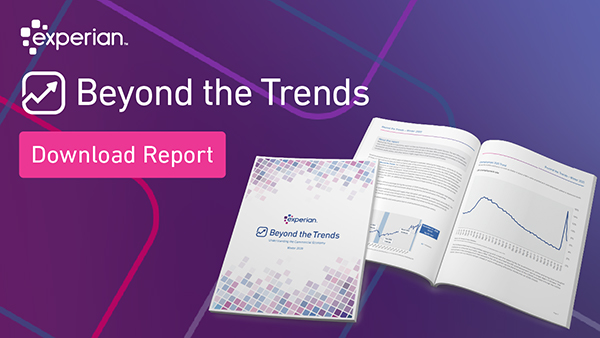
New Experian Report: Beyond the Trends Experian Business Information Services is excited to present our new quarterly report "Beyond the Trends." In this report, we'll be evaluating challenges to particular industries. We'll be looking at account management, pre-treatment, and treatment strategies for small businesses coming out of COVID. The Winter edition has just been released, download your copy below. . Download Report
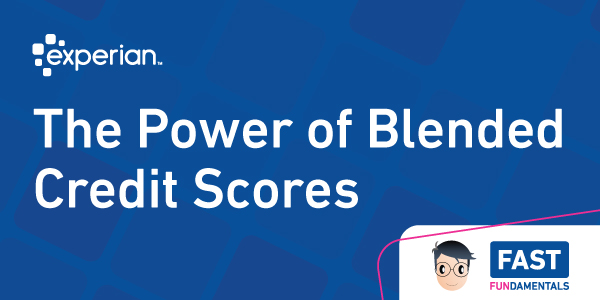
We get a lot of questions from our customers about blended credit scores vs consumer scores so, for our latest Fast FUNdamentals session, I thought it would be helpful to share what makes blended scores so powerful, and something you should consider when granting credit to small businesses. Watch our video or read the post, and remember to share it with your friends and colleagues. Small business growth fuels the U.S. economy through job creation and innovation! Small businesses support regional and local economies throughout the country, with higher proportions in middle America, and for every Walmart, Amazon, and Google, there are thousands of small business manufacturers, distributors, resellers, and app developers supporting their growth as well. In order to grow, small businesses need good ideas, a good business plan, hard work, and access to capital. Good credit is required to access capital, and many creditors look at the business owner’s consumer credit information from bureaus like Experian, to determine creditworthiness and credit risk. They tend to see small businesses and small-business owners as one and the same. However, this strategy is not always successful. The average consumer profile is quite different from the average business owner. Let’s look at how the profiles compare on some general consumer attributes associated with credit risk. The average owner has more trade experiences and has a longer credit history, which indicate lower risk. However, the owner also has higher credit utilization, which commonly indicate higher risk. Does this mean that the average owner is a higher credit risk than the average consumer? Not necessarily. Many small business owners rely to an extent on their personal credit to help finance their business. For public records, such as tax liens, judgments, and bankruptcies, the average is low for both the average consumer and owner. For collections, the average consumer has 5 times the amount to that of the owner. That’s indicative of higher risk. Another major indicator of credit risk is severe payment delinquency, and again, the average consumer is much more likely to be more severely delinquent than the average owner. Given that the average business owner looks and behaves differently from the average consumer, is there a better way to assess small business credit risk? A better way to assess small business risk Experian conducted a study to look at the relationship between the business and the owner’s credit behaviors over 3.5 years, to determine the strength of that relationship. We tracked the percentage of those businesses and owners that continued to remain credit active and healthy, and those that became high credit risks, becoming 91+ days delinquent on over 35% of all trade obligations. Over 3.5 years, 79% of the time, both the business and owner’s credit remained healthy. We tracked the percentage of those businesses and owners that continued to remain credit active and healthy, and those that became high credit risks, becoming 91+ days delinquent on over 35% of all trade obligations. Over 3.5 years, 79% of the time, both the business and owner’s credit remained healthy, and 5% of the time, both the business and owner became severely delinquent on the business obligations and on the personal credit obligations. That means that 84% of the time, the end result of business and consumer credit is the same! That’s a very strong correlation, so the owner’s consumer credit behavior is very indicative of business credit behavior. But, that also means that 16% of the time, the outcome of the business and consumer are diametrically opposed. 9% of the time, the business goes bad, but the owner stays good. If a creditor were to approve a business for credit based on the owner’s credit profile, the creditor would have made a bad decision. Furthermore, 7% of the time, the consumer goes bad but the business stays good. Blended risk scores provide better commercial risk assessment Blended risk scores predict business risk by utilizing the owners’ consumer credit attributes with the business credit attributes together – to calculate a more comprehensive risk score for the business With the blended risk score, creditors can more confidently approve those with a great score and know that they will have a profitable customer. And they may have to decline those with a high-risk score to mitigate against future loss. Let’s compare the predictive power of three risk models as the business ages, from infancy to full maturity In the below illustration, the horizontal axis going across measures the business as it ages, from 0 to 2 years on left, to 21+ years old on the right. The risk models compared are the Blended model, Commercial only model and Consumer model. Again, the Blended model uses both the business and consumer credit information to calculate the business risk. The Commercial only model uses just the business credit data to predict business risk and the Consumer model uses consumer credit data to assess the risk of the consumer, which is the business owner. The vertical axis measures KS, which is a metric representing the predictive power of each model in accurately identifying future good vs bad business credit outcomes. The KS is scaled from 0 to 100, with 0 indicating no predictive power and 100 Indicating perfect prediction. So, higher values indicate stronger model performance. For businesses in infancy up to 2 years, the Consumer risk score is more predictive of business risk than the Commercial risk score. That may seem counter-intuitive, but the underlying reason is that new and young businesses do not have a lot of credit activity on their profile. Many young businesses are actually funded by the owner’s personal credit, so there is less business credit information to calculate the business score. And in general, the less information available, the less predictive a model score will be. As the business matures, it establishes and expands its credit profile, opening more tradelines in the name of the business. As the business profile becomes richer in information, the commercial risk becomes more predictive than the consumer score. The business becomes a separate entity, and the consumer score becomes less and less indicative of business risk. Behaviors can differ dramatically from the business owner, as we have seen in previous examples. As expected, across all the ages of the business, the blended score provides superior performance. The blended score takes the age of the business into consideration as one of the factors for calculating risk, at every stage of the business lifecycle, the blended score provides a more holistic risk of the business by integrating the dynamic relationship between the business and owner credit profiles. Small business owners represent a unique market. They have an evolved sense of purpose, discipline, and responsibility that allows them to accept the risks and hardships required to build an enterprise from the ground up. To properly evaluate an entrepreneur’s credit risk, creditors must look at the right score. Utilizing a blended score is a proven, better way for creditors to evaluate risk and extend worthy businesses the capital they need to grow and prosper. And, as small businesses succeed, we all benefit.
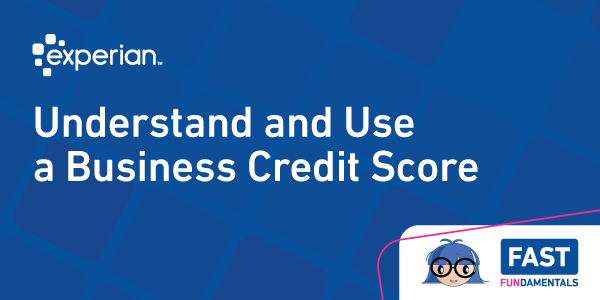
Credit risk scores predict credit risk in the near future, based on the credit profile of the business as of today. So you have a new applicant. What do you do? You get that credit risk score for those applicants with a great score; you're going to approve them and hope they'll be good customers for life. For those applicants with a high-risk score, you may have to decline them. This is the way it's supposed to work, but how do you know if the risk score works for your portfolio? What is the risk associated with the score specifically for you? To understand the risk of the score for your applicants, you can start scoring all new applicants as of today and wait 3, 6, 12 months. But who has the time to wait a year to see if the score predicts good versus bad outcomes accurately? Watch our Fast FUNdamentals Video A more immediate way is to score the newly booked accounts from a year ago and compare the score at application with the performance up to today. This process is called model validation. It's possible because Experian archives a snapshot of all business credit profiles and scores monthly going back more than a decade. Model validation results are represented through a performance table or odds chart. Let's go over a simple model validation odds chart. The risk score is scaled from 1 to 5, with 5 indicating the lowest risk and 1 indicating the highest risk. Younger businesses, businesses with minimal credit experience, or companies with severe delinquencies or collections would score low. This table shows the number of accounts that got each risk score. These columns show the number of accounts that say good or went bad within the first 12 months of account opening at the point of application. This is the bad rate for each score by knowing what the risk of the score is for your portfolio. You can understand the risk of new applicants going forward. A common metric used to determine a risk score's predictive power is KS named for its craters, Kolmogorof and Smirnoff. KS measures a score's ability to separate two populations. In this case, future goods and future bads. If more bads get lower scores and more goods get high scores, then the model is doing an excellent job of predicting credit risk. Let's quantify how good the model is performing by calculating KS. We see that 20 accounts got the worst score - a 1, and 12 of these accounts stayed good within one year of opening, and eight of these accounts went bad within one year of opening. Now let's add some columns that calculate values from the worst score on up. These are called the cumulative calculations. At the worst score of 1 there are eight bads captured out of 20 total bads, which is 40% of all bad accounts. At the score of 1 to 2 there are 14 bads captured out of 20 total bads, which is 70% of all bad accounts. At the score of 1 to 3 there are 17 bads captured out of 20 total beds, which is 85% of all bad accounts. Finally, at score of 1 to 5, there are 20 bads captured out of 20 total bads, which is 100% of all bad accounts. We go through the same calculations for the percentage of good captured. Let's calculate that KS now. At each score range, we subtract the percentage of goods captured from the percentage of bads captured. The KS is just the maximum difference between the percentage of bads captured and the percentage of goods captured. The KS is scaled from 0 to 100 with 0 indicating no ability to predict good versus bad outcomes, and 100 indicating perfect prediction. Let's see a model that can not predict credit risk at all. This model captures the same percentage of goods and bads at each score. So the maximum KS is zero. Now let's see how a model can get to a KS of 100. There it is, all bads got the worst score of 1 and no goods. All right, now that we understand how well the risk score predicts risk, let's discuss how we can apply your odds charts, make data-driven decisions. Let's say on average, you make $100 dollars on every excellent account, but you lose $200 for every bad. For each score we calculate the net profit by multiplying the number of goods by profit per good. Net loss by multiplying the number of bads by loss per bed. Now let's calculate the cumulative net profit and loss from best to worst score. We're simply summing the net profit and net loss amount as we go from a score of 5 down to 1. Lastly, we subtract the cumulative net loss from net profit at each score to determine the score cut. To maximize profit for all the accounts that score a 5, we're making a profit of $1,700. As we add lower-scoring accounts, our maximum profit continues to increase. When we add the accounts at score 1, the maximum profit decreases by $400. This means that we maximize profit by approving everyone that scores 2 and higher. For those that score 1, there are 20 accounts, and we're losing $400 from them. We can choose to decline them or charge them a deposit of $20 or more to be profitable because we're losing $20 on average per account here.
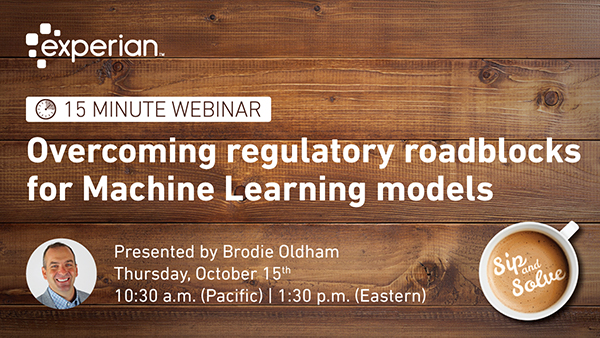
The concept of machine learning has been around for 50+ years in analytic circles. But machine learning methods have created a stir in the last few years as their popularity and visibility increased in the U.S. consumer and commercial credit industry. The use of these advanced methodologies has been constrained to mainly fraud/identity and collections. Machine Learning techniques are now available for credit decisioning. Our upcoming Sip and Solve session will provide insights to help your regulator feel more comfortable with the methodology you are using. We will share how Experian is making machine learning explainable to regulators and boosting model performance. During this session you will learn three take-aways: Current model governance basics How machine learning methods are boosting performance Best practices in deployment and documentation to help regulators feel comfortable with this more powerful solution
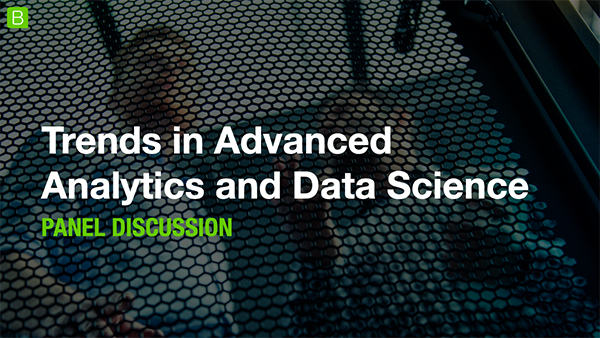
Matt Shubert, Experian's Director of Data Science and Modeling participated in a discussion about trends in AI and Machine Learning. He shared insights on how Experian Business Information Services is leveraging these technologies for clients. Matt and a panel of industry experts discuss how businesses are taking advantage of predictive analytics technology to gain a competitive edge in the marketplace. Webinar Highlights: - Use cases that show how AI and machine learning are helping companies be more proactive than ever - How predictive modeling can lead to more informed business decisions - What steps organizations can take to adopt an AI-enhanced analytics strategy that works for them - And more! Panelists: Puravee Bhattacharya, Senior Data Scientist and Analytics, BI & Performance Reporting at Energia Nirupam Srivastava, Vice President - Strategy and AI at Hero Enterprise Matt Shubert, Director of Data Science and Modeling at Experian
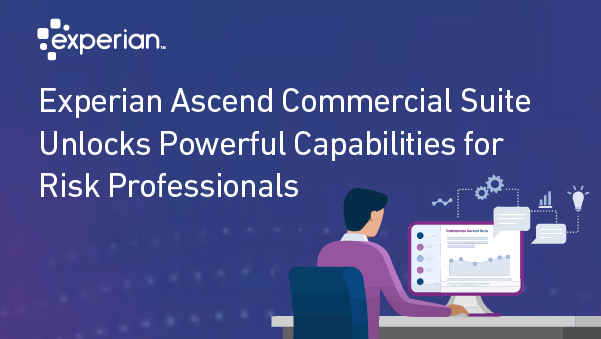
Experian® today announced Ascend Commercial Suite™ for financial institutions specializing in commercial lending as well as insurance carriers to drive growth while reducing risk. The suite includes Experian’s Ascend Analytical Sandbox™ configurations and a new Ascend Commercial Benchmarking Dashboard™ that provides access to industry-leading data on small and midsize businesses. “Experian is committed to creating opportunities for businesses to succeed,” said Hiq Lee, president of Experian’s Business Information Services. “During uncertain times, making fast, accurate decisions is critical for lenders so they can continue to extend credit responsibly to the businesses that need it most. Experian’s Ascend Commercial Suite enables clients to access world-class advanced analytics, AI, machine learning, and benchmarking tools so they can make real-time decisions that can ultimately help businesses on the road to recovery ahead.” Experian’s Ascend Analytical Sandbox is an industry-leading cloud-based data and analytics solution that offers flexibility in addressing lenders’ needs and offers instant access to up to 19 years of data. The secure hybrid-cloud environment allows users to combine their own data sets with Experian’s exclusive data assets, including consumer credit, commercial credit, nontraditional, auto, and more. Small and midsize business lenders, as well as insurance carriers, can seamlessly blend commercial and consumer small business data to get a 360-degree view of their overall small business portfolio to more easily identify risks and opportunities. It’s a one-stop-shop for insights, model development, and results measurement. The Ascend Commercial Benchmarking Dashboard delivers a comprehensive visual dashboard view of credit risk data and Small Business Financial Exchange™ (SBFE) Data exclusively for SBFE members. Clients can compare their portfolios against industry performance and analyze new market segments for potential growth and expansion. The insights available through the Ascend Commercial Suite can be viewed and shared through interactive dashboards and customizable reports. Additional use cases include: Portfolio performance and monitoring: Lenders can harness the power of Experian data to better monitor performance and quickly identify areas of strength or concern on visual dashboards without having to run custom reports every month. Model development and validation: Clients can monitor existing models and develop new models in order to improve risk profiles of new accounts and improve existing accounts. Blended analysis: Small business lenders relying on personal guarantees can use both consumer and business data to determine a customer or potential customer’s overall risk. Marketing analytics and acquisition: Lenders’ campaign information and results combined with Experian’s Credit Risk Database help them understand performance and improve marketing and segmentation. Decisioning for risk assessment and segmentation: Lenders and insurance carriers can optimize risk decisioning and segmentation strategies using analytical tools on one platform, which provides quick and efficient access to multiple integrated data sets. Reject inferencing: Lenders can load application data and use SBFE trade-level data to understand how declines performed if customers obtained credit elsewhere. Custom attributes to better analyze portfolios: With SBFE Data, lenders can create their own custom attributes or use Experian’s highly predictive set of attributes. Experian’s Ascend Commercial Suite is built on the Experian Ascend Technology Platform™. Launched in 2017, the Experian Ascend Technology Platform is recognized as one of the most successful launches in Experian’s history. It’s currently being used by the top financial institutions globally including the United Kingdom, South Africa, Brazil and Asia Pacific. Experian’s Ascend Analytical Sandbox was also selected in 2019 as the winner of the “Best Overall Analytics Platform” award by FinTech Breakthrough, an independent organization that recognizes the top companies, technologies and products in the global fintech market. To learn more about Experian’s Ascend Commercial Suite, please visit: https://www.experian.com/business-information/ascend-commercial-suite.
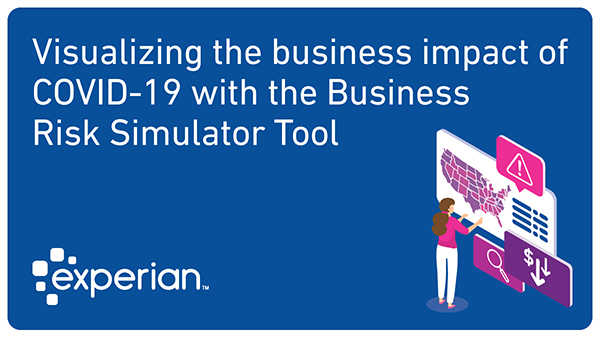
For the past month, the Commercial Data Sciences team in Business Information Services has been taking precautions in response to the Coronavirus Pandemic, working from home. In the span of the past five weeks, we have seen the spread of the disease ramp up, and the death toll climbs. The impact on businesses of all sizes will be immense. In just a few days we built a robust simulator tool that helps businesses assess the impact of COVID-19 as the disease spreads. With this tool, you can: Identify risk in geographies you do business in Based on geography, review the top 5 riskiest industries for that region Apply an impact scenario so you can plan for the best and worst-case scenarios The U.S. business risk dashboard below was developed by Experian Business Information Services to help businesses better understand the impact COVID-19 may have on their commercial operation based on several key factors. This methodology combines business risk, anticipated impact on business industries and real-time COVID-19 case data to help businesses better simulate various impact scenarios down to the state level to help develop enterprise strategies. A paid version of the dashboard goes down to the county and industry level. The risk index is used as a comparative benchmark across states, counties and industries. Industry classification is used to assess the business’s level of exposure due the nature of the business. For example, businesses in the Arts, Entertainment, and Recreation industries will be more heavily impacted than businesses in Public Administration. The risk index represents the credit risk, industry risk, and COVID-19 risk on businesses across the U.S. The impact layer allows users to easily change the severity of the impact related to the combination with the credit risk, industry risk, and COVID-19 risk across regions and industries. This dashboard is meant to be a directional tool for assessing which industries and geographies are most likely to be impacted and how severe the impact will be. The risk index is not designed to be interchangeable with a traditional credit risk score. The risk index is intended to be used independently to gain insights around the potential impact of the current events on future business credit health at summarized levels including region and industry. The risk index has four different assessment scenarios ranging from low to severe. If the expectation is that various industries are affected differently, but the impact overall is minimal, then the minimal scenario should be applied. Select the other scenarios to amplify the impact.
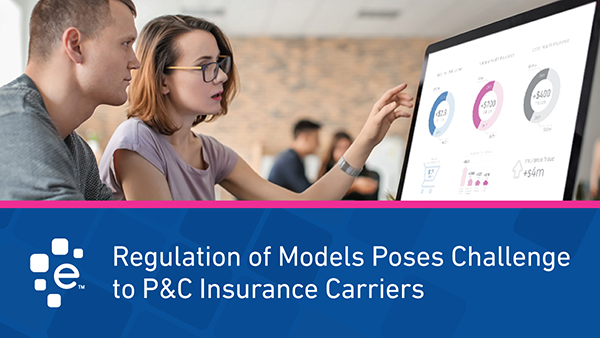
Serving commercial Property & Casualty insurers is a major objective of 3rd parties in the analytics and data space. This industry vertical is one in which standard credit tools already apply to the carrier’s challenge in managing claims risk; there is continued investment within and beyond the industry in developing innovative tools for this purpose. However, a smooth roll out of such tools at scale requires a comprehensive understanding of the regulatory process and its constraints. US Insurance industry- overall regulatory structure: Currently, US carriers are regulated primarily by the individual states, a result of the 1945 McCarran Ferguson Act (“MFA”). Less known is that the MFA was presaged by the Paul v Virginia decision (1869, later overturned by SCOTUS) that held that issuing an insurance policy was not a commercial transaction! [1]. Federal regulatory guidance, ultimately from the Office of the Controller of the Currency (OCC) and the Federal Reserve Board (FRB), is implemented via the National Association of Insurance Commissioners (“NAIC”; see below). NAIC organizes the insurance commissioners from all 50 states, Washington DC, and territories. NAIC maintains legislative databases, market conduct standards, industry financial reporting, conducts training, and many other functions. NAIC provides supervisory guidance for the use of models used to predict insurance loss risk. Among other functions, NAIC has created the Own Risk and Solvency Assessment (“ORSA”) framework which implements existing OCC and FRB guidance to the states. Capital reserves needed for solvency as well as business conduct -- including product definition and general business operations, licensing, maintaining a guaranty fund, underwriting, and rate setting-- are determined primarily by the states in which the carrier operates [2]. Today’s system of state-by-state regulation is more challenging than an equivalent centralized regulating body; insurance carriers operate increasingly online, driving the need for multi-state operations which in turn require multistate licensing and complex regulatory compliance. The average property liability firm has 16 state licenses, while the average life insurance carrier has 25. The coordination of state insurance laws, as well as many other quasi-governmental insurance industry functions, falls under the aegis of the NAIC. We will focus our discussion here on the regulation of risk models. How should third parties align the model building with regulatory requirements? Example 1: Basic filing and disclosure protocol: Responsibility to disclose to state regulators typically lies with the developer or the owner of the model. Disclosure responsibility for custom risk models built around the data of a specific client insurer resides with the insurer, while industry standard models used for multiple clients are typically disclosed by the model developer. Reporting and disclosure requirements vary by state. While the most central functions of interest by state regulators are underwriting and rate setting, any other use of models by insurers may be subject to regulatory disclosure. Models used to assess loss risk for rate setting or underwriting purposes are typically examined for discriminatory impact and use of prohibited data in addition to adequate risk performance and numerical stability. “Prohibited data” varies by state but may include certain data elements gleaned from in-state residents, federal crime data, certain credit data elements, traffic violations exceeding a specified age on the books, or other data; the section below deals with credit data. Finally, the requirement to disclose model details such as attributes and weightings also vary between states, and may require the developer to invoke trade secret status for the subject models to avoid disclosure to the public (implicit in many states). The adjudication of such claims is variable between states, as are all communications with regulators on this topic. Example 2: Use of consumer credit information to underwrite personal insurance policies: Using credit information in models to predict loss risk on personal insurance contracts also has a rich and extremely active history in the US. P&C insurers have generally found that credit risk and claims risk are positively correlated. They have used credit data on individual consumers to various degrees. Notably, the Consumer- Based Insurance Score (CBIS) employs consumer credit parameters and has been used across the insurance industry since 1993. Amid vigorous debate, states have seen active legislative attempts to restrict and define allowable use of consumer credit data by insurers. Credit information in some cases can outweigh a consumer’s driving record in setting rates- leading to the bitter but factual observation that excellent consumer credit can literally outweigh a DUI conviction in some states and conditions. In 2016 alone, the state legislative actions below were considered and/or enacted; note once again that the ability of individual states to regulate independently greatly complicates the picture for large carriers operating in multiple states: California, Hawaii, and Massachusetts do not appear in the table above. In those states, consumer credit information cannot be used to underwrite personal auto policies. Example 3: Reporting channel: State regulators typically require use of the System for Electronic Rate and Form Filing (“SERFF”) database maintained by NAIC for formal submissions: https://login.serff.com/serff/ What’s coming down the road? We have seen examples of the dependence of applicable insurance regulations on individual state laws; the mechanics of model development requires understanding and working with these restrictions. Basic filing and disclosure, permissible model variables, the proprietary status of model detail, and the use of certain consumer information (e.g., credit scores, driving records) are all aspects of risk models whose successful execution depends on understanding the widely variable set of existing state regulations. Several authors have cited the need for a shift in the underlying regulatory structure of the industry from state-based to a national system, citing the inefficiency of the licensing process and the true interstate nature of today’s distribution system. A centralized federal insurance regulatory body would simplify interstate compliance by carriers, but would also introduce other complications. However, it appears prudent in the near-term for 3rd parties developing models to gain awareness of, and streamline, current requirements for regulatory compliance at the state level. Conclusion: There is a considerable additional value that the next generation of models will contribute to the commercial P&C vertical. Insurers and 3rd party developers have demonstrated the applicability of their models and data reports, offering competitive added value with standard risk scores adapted from the credit domain. However, promoting these products more broadly and expanding the product offerings themselves into cyber risk, commercial linkages, and various other tools for insurers, the insurance industry faces efficiency hurdles from our 50-state regulatory framework. With any regulatory centralization unlikely near term, 3rd parties thus need to gain working fluency in NAIC and in the SERFF database, anticipate state-level documentation and disclosure requirements, and attain a level of familiarity with state regulatory machines that enables the management of the interests of their clients with confidence. How Experian can help you Experian provides analytical services for Property & Casualty as well as other insurance product verticals. To enable you to assess claims risk at the time of policy application (or renewal), we either apply standard risk models or develop custom risk models to your underwriting and rate-setting processes. To help you guard against cyber fraud, false identity, and reputation risk, we offer specialty products as well. We also offer special purpose, custom analyses on request, and we sell curated commercial data to your standards as well. References: [1] Brookings Institute. paper on future of regulation- Grace & Klein [2] Insurance Information Institute: Regulation [3] Grant Thornton: ORSA requirements: Model Risk Management for Insurance Companies [4] Blueprint for a Modernized Financial Regulatory Structure, Dept. of Treas., 2008
